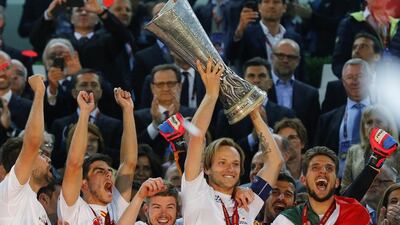TURIN, Italy // Rewards for winning the often-unloved Europa League are getting bigger, maybe even large enough to ignite more interest in countries such as England and Italy.
Sevilla's penalty shoot-out victory over Benfica on Wednesday in the Europa League final was the tournament's last championship game before Uefa begins offering the winners a place in the following season's Uefa Champions League field.
“By introducing this reward, there is a feeling that teams will take it more seriously,” Uefa events marketing director Guy-Laurent Epstein said.
An expected 20 per cent increase in prize money from 2015 should also help, with clubs expected to share about €250 million (Dh1.25 billion).
The European Club Association says its 200-plus members are happy with the Europa League. However, it acknowledges a need to close a “big financial gap” between the globally successful Champions League and an event rebranded from the Uefa Cup five years ago.
Today, that gulf is more than €1 billion each season.
“We have to be pragmatic. Europa League is not Champions League,” Epstein said ahead of the final. “It’s for teams that are more community [based] rather than international brands most of the time.”
Sevilla is one club where the Europa League has no image or identity issues.
“It’s a competition our fans really like,” said Sevilla coach Unai Emery, whose club won the former Uefa Cup in 2006 and 2007. “We thought we had the responsibility to win.”
Still, even those Uefa Cups were different to its 1970s and 1980s prime.
Then, there was a popular trinity of Uefa competitions: the European Cup for national champions; the Uefa Cup for runners-up and other high-placed teams; and the Cup Winners Cup.
After the European Cup became the Champions League in 1992 – giving more games to elite clubs – the other two declined until the cup winners’ event was abolished in 1999.
The Europa League was launched in 2009 to rebrand an event bloated with clubs, playing in unfamiliar Thursday slots and a complex format with Champions League losers coming over at different stages.
Some clubs judged the Europa League not worth the bother and effectively fielded reserve teams. That was despite Porto and Atletico Madrid using the second-tier title as a springboard.
Coached by Jose Mourinho, Porto won the Uefa Cup in 2003 and the next year’s Champions League. Atletico Madrid will play city rival Real Madrid for the biggest club prize next week after winning Europa League titles in 2010 and 2012.
Epstein said feedback from England had been “rather negative”, but believes that will change, helped by Chelsea winning the title last year.
Italian clubs need good Europa League results to boost their rankings in a long process to regain a fourth Champions League entry for Serie A. Winning the Europa League is a faster road to that goal.
The cash prize from Uefa for winning the Europa League is typically about €14 million. Sevilla earned its share during a 19-match, nine-month labour.
Nice money in the Financial Fair Play era, yet only half of what a big-market club gets for a six-match trip through a Champions League group that ends in December.
Adding the Europa League’s annual €40 million subsidy from the Champions League, Uefa distributes about €210 million directly to clubs taking part. Most of the €1.3 billion-plus Champions League annual commercial revenue is spread among the 32 group-stage clubs. Top earners receive more than €60 million.
Epstein said he expects rising Europa League earnings for the 2015 to 2018 seasons.
“I think it will pass the €300 million bar in the next cycle,” he said.
sports@thenational.ae
Follow us on Twitter at @SprtNationalUAE

